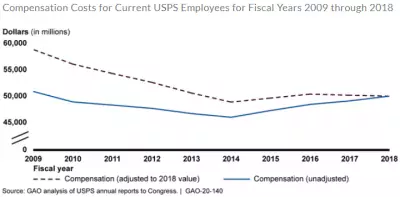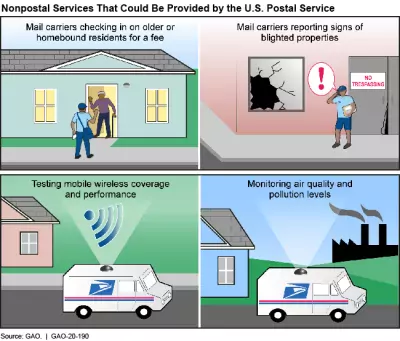Checking in with the Postal Service on its 228th Anniversary
On this day in 1792, President George Washington signed legislation that established the modern-day U.S. Postal Service.
Fast forward to 2020, and the Postal Service has over 634,000 employees who—on a typical day—deliver 493 million pieces of mail. The Postal Service is one of the largest civilian employers in the United States. It’s also one of the nation’s largest employers of minorities, women, veterans, and disabled veterans.
In today’s WatchBlog, we look at challenges facing today’s Postal Service and some of the options to address those challenges.
The struggle to make ends meet
The Postal Service gets the money it needs to operate primarily from what it charges customers for products and services.
The Postal Service’s most profitable product—First-Class Mail—is expected to continue to decrease in volume as people send fewer letters and companies send fewer customer bills and statements. And while the volume of packages the Postal Service delivers has increased significantly over the past decade with the rise in online retail, there’s stiff competition in the package shipping industry.
Over the past 11 years, the Postal Service has lost over $69 billion. And the outlook isn’t expected to improve without major changes. The financial viability of the USPS has been on our High Risk List since 2009.
The effort to control compensation costs
As the Postal Service’s revenues have declined, major costs, like employee pay and benefits, have risen. In response, the Postal Service took steps to lower its employee compensation costs, such as by paying new employees less and reducing the number of employees.
However, we found that the Postal Service overestimated its costs savings from these efforts. Also, the Postal Service’s estimates didn’t consider factors like training and other costs associated with increased turnover due to lower wages. We recommended including such factors in savings estimates, so the Postal Service has the information it needs to better assess its workforce.
Delivering more than mail
Cutting costs is one thing, but what about the revenue side of the equation?
The Postal Service has a vast network of mail carriers and vehicles. Some have suggested it leverage that network to provide additional services that could generate revenue or enhance its value to communities.
We found that such services may indeed increase the Postal Service’s value to communities and could generate more revenue. However, these ideas have a number of limitations and likely would not significantly improve the agency’s financial position.
While these measures may not be the silver bullet for the Postal Service’s financial issues, we have recommendations that could help. Check out our High Risk Report for details on what Congress and the Postal Service need to do to help put the Postal Service on a more sustainable financial footing.
- Comments on GAO’s WatchBlog? Contact blog@gao.gov.
GAO Contacts
Related Products

GAO's mission is to provide Congress with fact-based, nonpartisan information that can help improve federal government performance and ensure accountability for the benefit of the American people. GAO launched its WatchBlog in January, 2014, as part of its continuing effort to reach its audiences—Congress and the American people—where they are currently looking for information.
The blog format allows GAO to provide a little more context about its work than it can offer on its other social media platforms. Posts will tie GAO work to current events and the news; show how GAO’s work is affecting agencies or legislation; highlight reports, testimonies, and issue areas where GAO does work; and provide information about GAO itself, among other things.
Please send any feedback on GAO's WatchBlog to blog@gao.gov.







